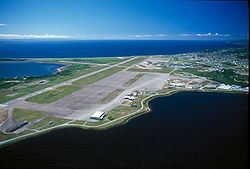| Stephenville Dymond International Airport | |||||||||||
|---|---|---|---|---|---|---|---|---|---|---|---|
 | |||||||||||
| Summary | |||||||||||
| Airport type | Public | ||||||||||
| Owner | The Dymond Group of Companies | ||||||||||
| Operator | Stephenville Dymond Airport | ||||||||||
| Location | Stephenville, Newfoundland and Labrador | ||||||||||
| Time zone | NST (UTC−03:30) | ||||||||||
| • Summer (DST) | NDT (UTC−02:30) | ||||||||||
| Elevation AMSL | 81 ft / 25 m | ||||||||||
| Coordinates | 48°32′40″N 058°33′00″W / 48.54444°N 58.55000°W / 48.54444; -58.55000 | ||||||||||
| Website | www.cyjt.com | ||||||||||
| Map | |||||||||||
  | |||||||||||
| Runways | |||||||||||
| |||||||||||
| Statistics (2023) | |||||||||||
| |||||||||||
| Sources: Canada Flight Supplement Environment Canada Movements from Statistics Canada | |||||||||||
Stephenville Dymond International Airport (IATA: YJT, ICAO: CYJT) is an airport located 1 nautical mile (1.9 km; 1.2 mi) south southeast of Stephenville, Newfoundland and Labrador, Canada. It was built by the United States Army Air Forces and operated as Ernest Harmon Air Force Base from 1941 to 1966.
The airport is classified as an airport of entry by Nav Canada and is staffed by the Canada Border Services Agency who are able to process general aviation with up to 30 passengers.
History
In 1941 the United States obtained rights to construct a United States Army Air Forces base in the St. George's Bay area of Newfoundland. The U.S. 76th Congress approved the 99-year lease and in April 1941, construction began.
On September 1, 1943, the Newfoundland Base Command transferred control of Harmon Field to the North Atlantic Wing, Air Transport Command.
The USAAF base was built as Stephenville Air Base. However, after the USAAF became the United States Air Force in 1947, it was renamed Ernest Harmon Air Force Base on June 23, 1948, in honour of Captain Ernest Emery Harmon. Harmon was a US Army Air Corps ace who was killed in an air crash in 1933.
The base became a part of the Northeast Air Command in October, 1950. Then in April 1957, the Strategic Air Command assumed control.

The mandate of the base was to maintain a tanker alert force and its capability to meet and refuel Strategic Air Command jet bombers en route to targets. The Boeing KC-97 Stratofreighter was employed in this task.
The base was also used as a refueling stop for transatlantic military flights. In addition, Harmon supported three Air Defense Command units. In 1957, the Canadian Department of Transportation constructed an airport terminal to accommodate Trans-Canada Air Lines (now Air Canada). 1966 saw the closure of the U.S. Air Force Base in Stephenville.
The airport is now owned and operated by the local airport authority, the Stephenville Airport Corporation Inc. Stephenville Airport was designated as an alternate in the Trans Oceanic Plane Stop (TOPS) program on July 23, 1970.
The Stephenville Airport was the major passenger airport for all of western Newfoundland until the early 1990s when provincial government decided to direct more traffic to the Deer Lake Regional Airport. All major Canadian carriers used Stephenville such as Air Canada, Eastern Provincial Airways and Canadian Airlines.
Stephenville International Airport was one of the locations of Operation Yellow Ribbon on September 11, 2001.
On February 1, 2018, the Canada Flight Supplement indicated that runway 02/20, which was 3,959 ft (1,207 m) long, had been closed.
In 2020, as a result of the COVID-19 pandemic, the airport suffered notable cuts to its airline routes. All airlines never returned to Stephenville as commercial aviation increased across Canada and at nearby Deer Lake Regional Airport.
Operation Yellow Ribbon
On September 11, 2001, eight civilian airliners made unscheduled landings at the Stephenville Airport following the closure of North American airspace in the wake of the terrorist attacks on New York City and Washington, D.C. As a participant in Operation Yellow Ribbon, the town hosted nearly 3,000 stranded passengers for approximately one week.
Services

- Islander's At the Airport restaurant
- Airport check-in counters are vacant
- Ground transportation to and from hotels
- Passenger lounge
References
![]() This article incorporates public domain material from the Air Force Historical Research Agency
This article incorporates public domain material from the Air Force Historical Research Agency
- ^ Canada Flight Supplement. Effective 0901Z 16 July 2020 to 0901Z 10 September 2020.
- Synoptic/Metstat Station Information
- Total aircraft movements by class of operation
- "Home". Stephenville Dymond International Airport. Retrieved 2023-09-02.
- "Airport". www.stephenville.ca. Retrieved 2024-01-30.
- Canada, Transport (2014-01-07). "Four Days in September". Transport Canada. Retrieved 2024-01-30.
- "Stephenville airport loses summer flights from Porter, Sunwing | CBC News".
- Chris Lambie. Halifax possible shuttle pit stop, The Chronicle Herald, July 5, 2006.
External links
- Airport website
- Page about this airport on COPA's Places to Fly airport directory
- Past three hours METARs, SPECI and current TAFs for Stephenville Airport from Nav Canada as available.
| Airports in Canada | |
|---|---|
| By name | |
| By location indicator | |
| By province/territory | |
| By area | |
| National Airports System | |
| Related | |
| Bases |
|  | |||||||||||
|---|---|---|---|---|---|---|---|---|---|---|---|---|---|
| Stations |
| ||||||||||||
| Air Defense units |
| ||||||||||||
| Major weapon systems |
| ||||||||||||
| Miscellaneous |
| ||||||||||||
